
The Fenice Schifanoia: the genius of Francesco del Cossa and Ercole de Roberti returns to light in the palace of Borso dEste
The Salone dei Mesi in the Palazzo Schifanoia in Ferrara is one of the greatest masterpieces of Renaissance painting. And now it is being resurrected in a new light.
By Giovanni Sassu | 23/06/2020 16:49
It is a story of dazzling ascents and ruinous falls that of Palazzo Schifanoia. Throughout its history, in fact, the ancient Este delight has suffered wounds of all kinds caused by improper "civilian" uses no less than by natural disasters. This combined action has resulted in amputations, concealments and structural fragilities that have often called its very existence into question.
From such crises the Palace, one of Ferrara's symbols, has always emerged rising like a Phoenix from its ashes: it happened with the 1570 earthquake, for example, or with the late 19th-century redemption that made it the city's Civic Museum. And it's happening again now, crowning a careful structural restoration overseen by the Municipality of Ferrara's Monumental Heritage Service after the 2012 earthquake, with the return of the building's heart to visitors.
As of June 2, in fact, it is possible to return to visit the Salone dei Mesi, the Sala delle Virtù and the Sala delle Imprese with the rooms illuminated as never before enriched by a short but tightly-packed exhibition entitled Francesco del Cossa and Schifanoia. L'oro degli Estensi(until September 14, 2020, organized by the Musei di Arte Antica and the Fondazione Ferrara Arte, under the patronage of theAssociazione Beni Italiani Patrimonio Mondiale): a selection of works pertaining to the Musei di Arte Antica most closely connected to the figure of Borso d'Este and a significant group of "guests" linked to theFerrara Workshop. A narrative in stages that crosses the magnificence of Este court art with sacred art and reconstructs the dialogue between artistic techniques that made Ferrara a privileged scenario of seminal experimentation for other centers as well (it is no coincidence that the exhibition ends in the presence of Giovanni Antonio Bazzi's fascinating Pala Grossi, a sort of Cossesque regularization executed for Reggio Emilia about twenty years after Schifanoia). An itinerary that is not intended to be just an exhibition, but a concrete anticipation of the museographic choices that will characterize the new Schifanoia Museum, whose final opening is scheduled for the coming months.
But the most incisive novelty is the new lighting system in the Salone dei Mesi. The entire wall surface (from Cossa's shiny plasters to those detached and transported to another support on the north wall, to the jagged and fragmentary dry-decorated ones) is revealed in a new and almost miraculous light thanks to the visionary yet profoundly rigorous genius of Alberto Pasetti Bombardella, designer of a lighting system that redefines the perception of this extraordinary masterpiece. Respectful at the same time of conservation standards and the needs of perception, it allows the eyes to embrace a Salon with no more shadow zones, perfectly balanced in its colors and shapes. A whole new museum light that is accompanied, at certain times of the day, by a dynamic sequence that immerses the Salone in shadow and then reveals it form after form, inviting the visitor to an active and emotional fruition that has no equal in Italy at this time.
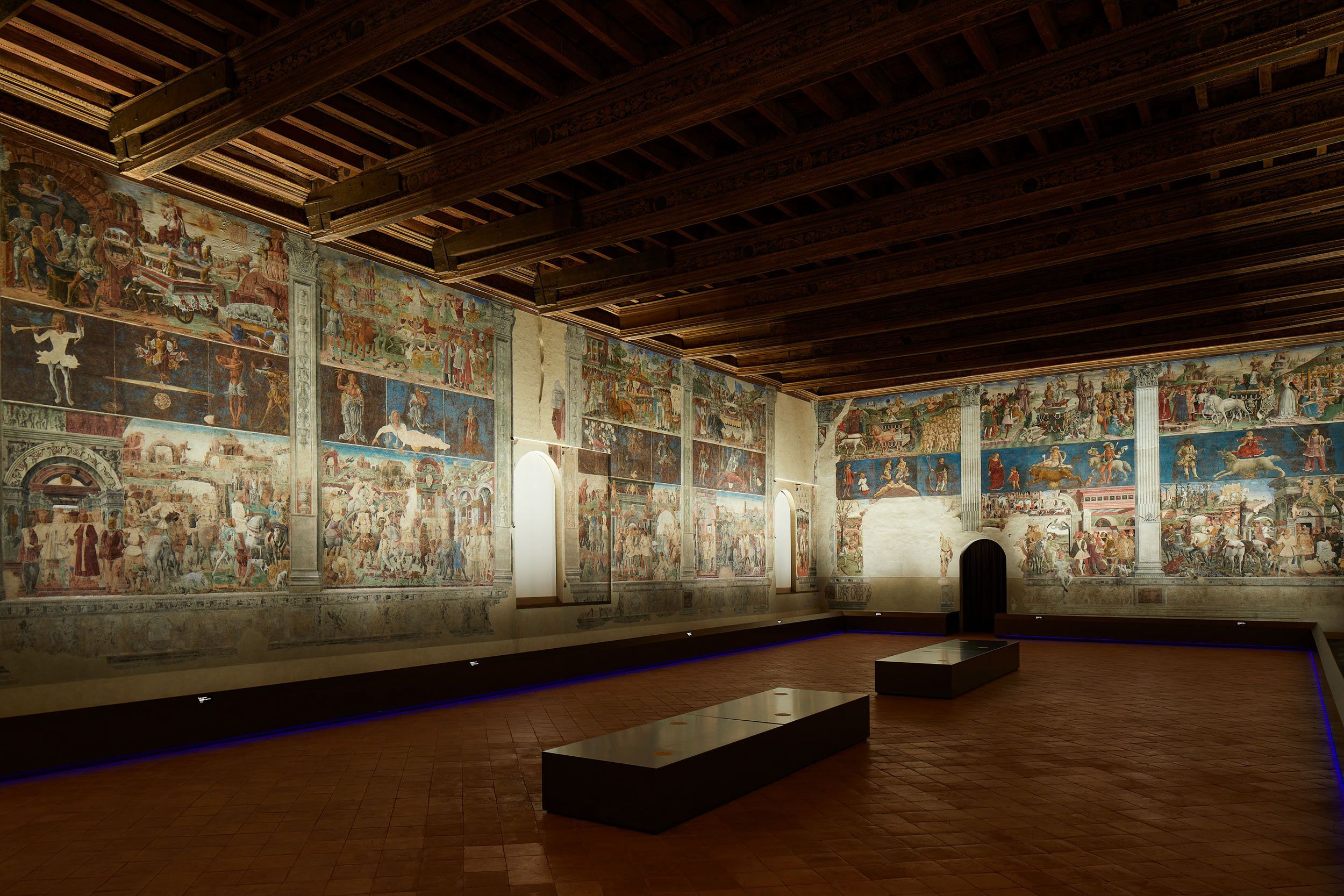 |
| Palazzo Schifanoia, Salone dei Mesi: view of the north and east walls, with the new lighting designed by Studio Pasetti Lightining. Ph. Credit Henrik Blomqvist |
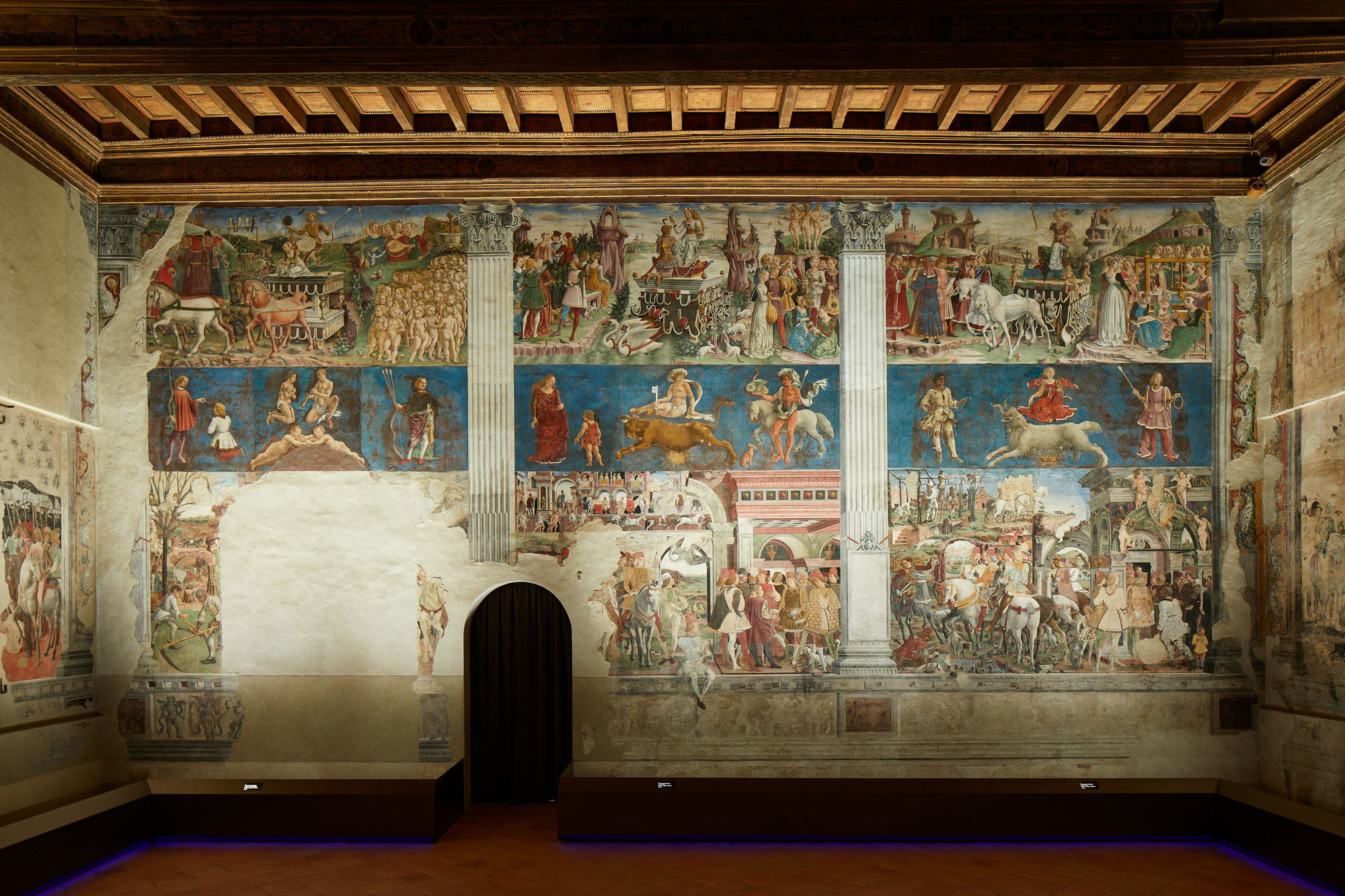 |
| Palazzo Schifanoia, Salone dei Mesi: east wall, months of March, April and May (Francesco del Cossa, 1469-70). Ph. Credit Henrik Blomqvist |
The astrologer, the marquis, almost duke, and his painters
Between 1466 and 1470 Marquis Borso d'Este (Ferrara, 1413 - 1471) invested in Schifanoia attentions equal to those lavished on the creation of the celebrated Bible that bears his name (now in Modena, at the Biblioteca Estense), commissioning the architect Pietro Benvenuto dagli Ordini to expand the pre-existing delizia. The result is a magniloquent, modern government palace equipped with an imposing monumental external staircase (now destroyed), a monumental portal and a spectacular facade decorated with painted geometric motifs (unfortunately lost) that simulated polychrome marble reliefs.
The centerpiece of it all is immediately the magical Hall of the Months: a masterpiece willed by the prince's determination, conceived by the culture of his court astrologer, Pellegrino Prisciani (Ferrara, 1435 - 1518), and realized by the skill a handful of artists called upon to work on it elbow to elbow and under tight deadlines, according to an operational model pioneered by Borso himself a few years earlier, when he ordered "all the painters of Ferrara" to come to the Court Palace on the occasion of the visit of Frederick III. The result is a room originally decorated by about 525 square meters of wall paintings: one of the most extensive secular decorative cycles of the 15th century (consider that Mantegna's famous Bridal Chamber in Mantua measures about 100), of which today we can fully appreciate only the portion painted in fresco between March and September because the other, made with drywall, has half disappeared.
An immensity of shapes and colors, the summa of the "profane and ornate" style of the Ferrara workshop, which represents the crowning achievement of a real policy of images that the then marquis was elaborating in anticipation of the imminence of the papal grant of the title of duke of Ferrara. Thus, while the Gonzaga celebrated the lineage in Mantua in the Bridal Chamber and the Sforza prepared to renew the decorations of the castles of Milan and Pavia, within the walls of the Salone Borso elaborated a monument to himself, his style of government, his court, and his ability to administer justice and territory. And he does so by mixing mythology of ancient derivation (the Triumphs of the Gods towering over and protecting each month), theArabic-derived astrology of the zodiac signs and their decans that bewitched Aby Warburg in 1912, with the exigencies of propaganda. It is hard not to imagine that Ludovico Ariosto had precisely the Salone di Schifanoia in mind when he described Borso as the one who "will close Mars where he sees no light, and clasp the Furor's hands to his back. Of this splendid lord every intent will be that his popul lives content"(Orlando furioso, III/45).
Borso appears three times in each month while playing the role of arbiter of peace, receiving ambassadors, parading in a parade or devoting himself to the pleasures of the hunt, always surrounded by his trusted courtiers: a veritable portrait obsession whose genesis, as the current exhibition shows, is to be traced to the rebirth of the medal in the antique style, familiar in Ferrara thanks to Pisanello's stay in the Este family, but which finds here an affirmation of a modern, ceremonial and propagandistic stamp.
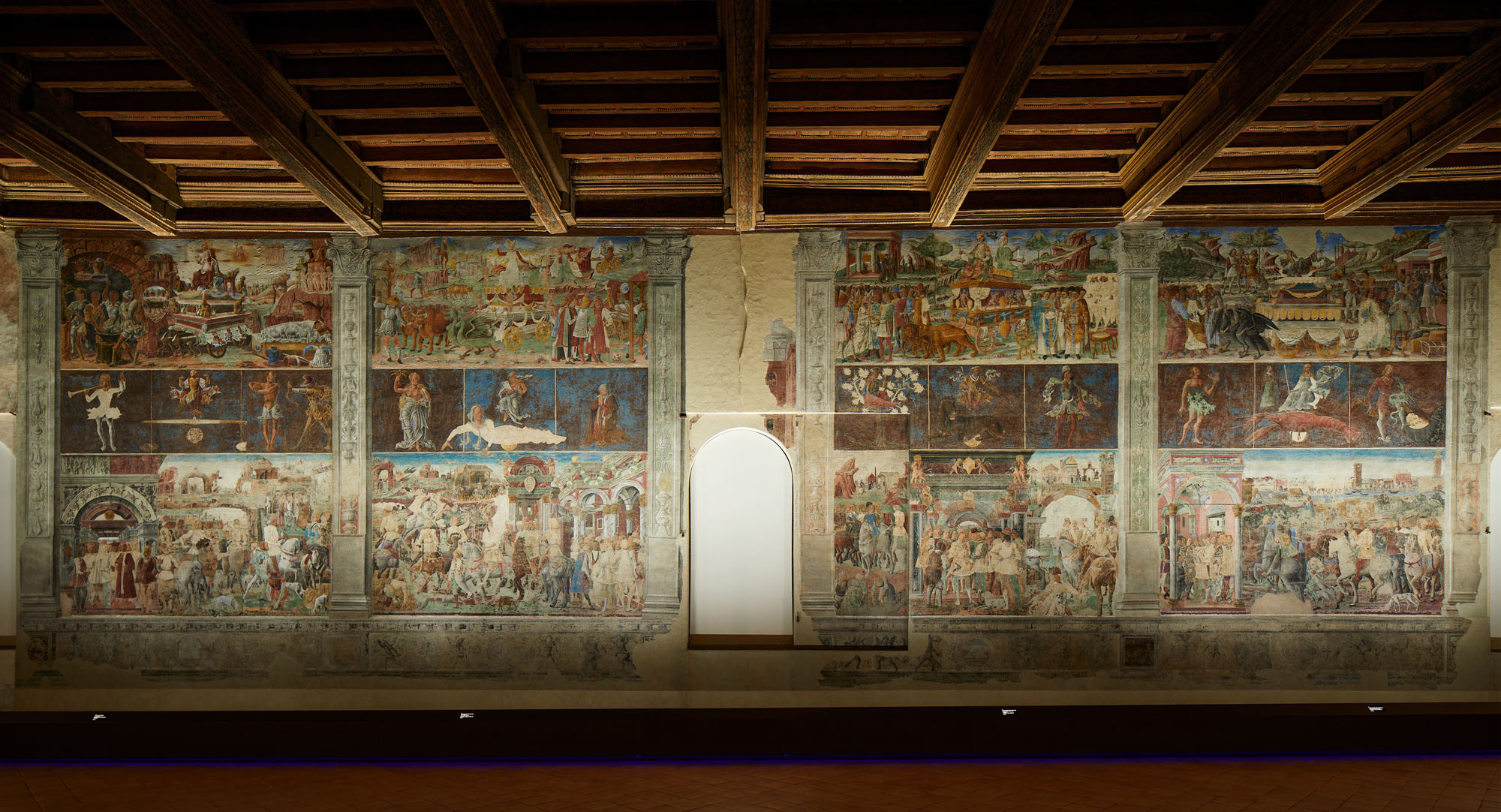 |
| Palazzo Schifanoia, Hall of the Months: north wall, months of June, July, August, September (Master with wide eyes, Master of August, Ercole de'Roberti, 1469-70). Ph. Credit Henrik Blomqvist |
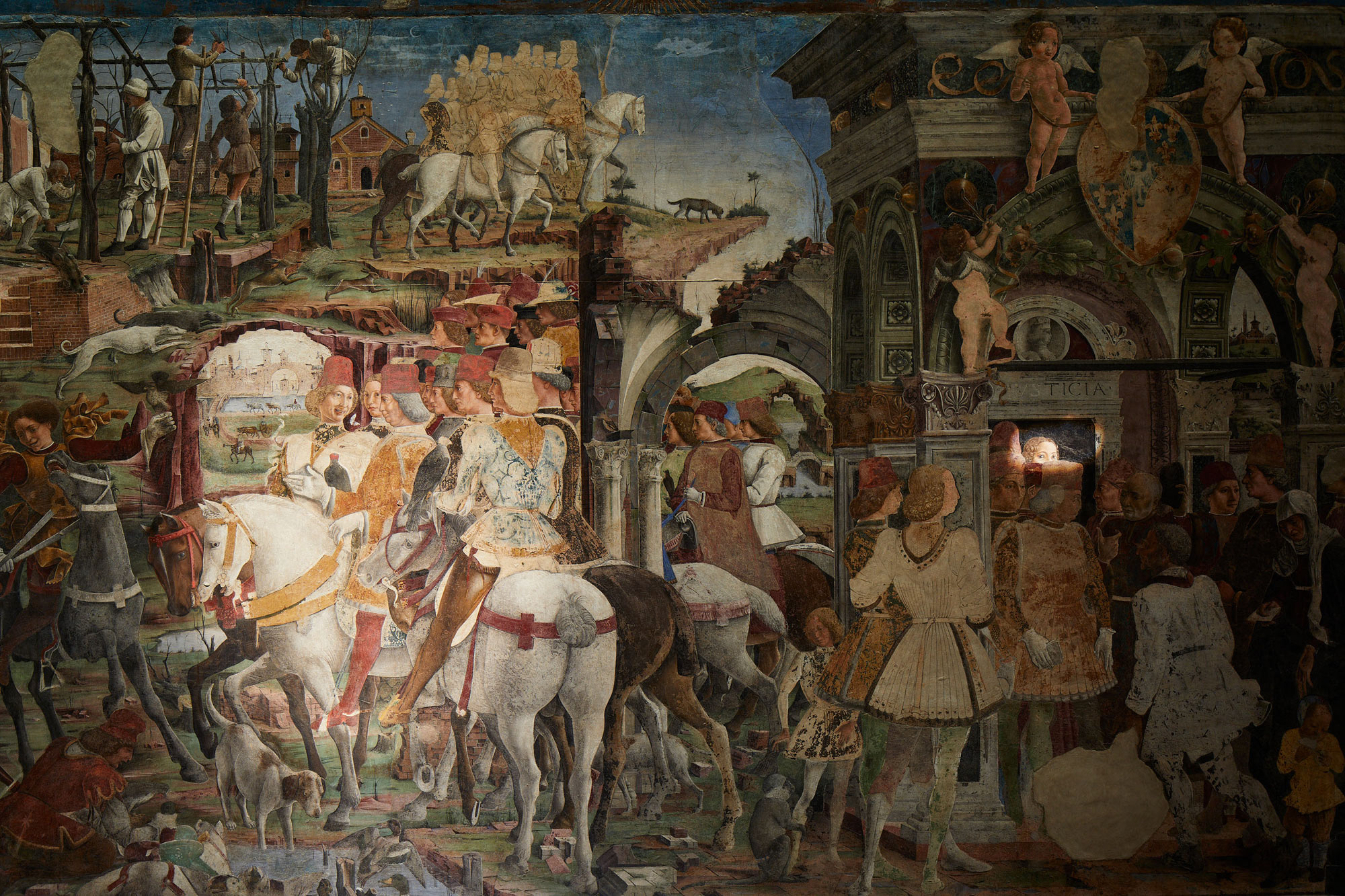 |
| Palazzo Schifanoia, Salone dei Mesi, March, detailing scenes of life at the court of Borso dEste (Francesco del Cossa, 1469-70) during the light sequence. Ph. Credit Henrik Blomqvist |
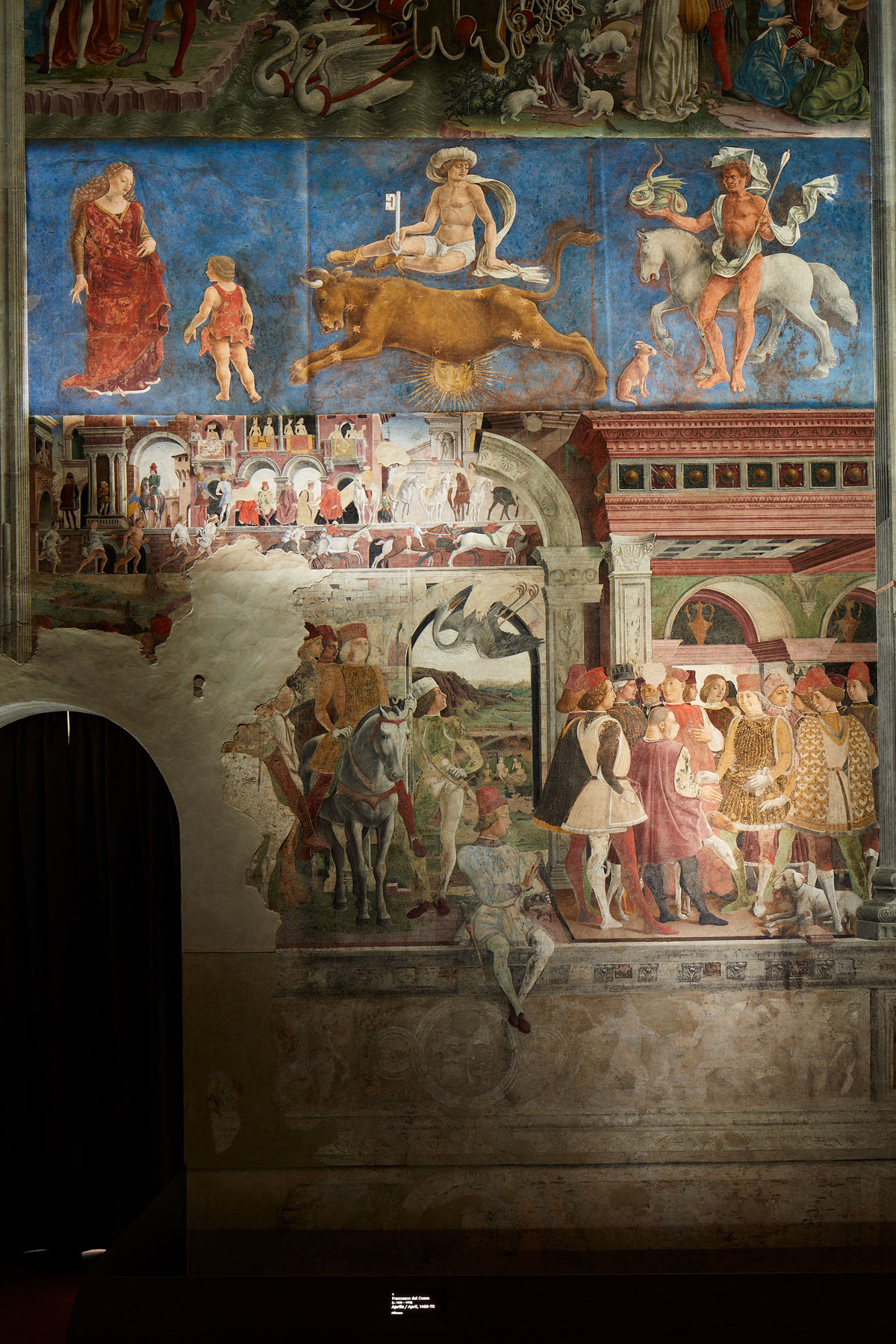 |
| Palazzo Schifanoia, Salone dei Mesi, east wall, April (Francesco del Cossa, 1469-70) during the light sequence. Ph. Credit Henrik Blomqvist |
Francesco del Cossa's masterpiece and Ercole de' Roberti's beginnings
Shaping everything is a patrol of artists directed by Prisciani and, probably, by an artistic director who in the past has been identified, without success or credibility, as Cosmè Tura. The necessity of this figure, because at Schifanoia nothing is left to chance, emerges when it comes to making the effigy of the marquis, repeated through the use of preparatory cartoons that are replicated independently of the author of the month: the portrait on horseback surrounded by dignitaries, for example, is reproduced by different artists and with subtle variations in the months of February, March, June, July and August. This is a kind of new equestrian portrait that, according to some scholars, Borso may have worked out together with his half-brother Baldassarre d'Este, his official portraitist starting right from Schifanoia and who would be called upon, when the work was finished, to standardize the prince's faces in the Salone: reflecting, perhaps, his role as figurative director.
Within such a grid of tasks and schemes stands out, in quality and intensity, the genius of Francesco del Cossa (Ferrara, 1436 - Bologna, 1478), perhaps Borso's least beloved painter, who at the end of the work, in March 1470, had the courage to claim a salary treatment equal to the masterpiece he had created. The marquis' refusal motivated the removal from Ferrara of the painter, who returned to the Bologna he had visited shortly before and found the fame and recognition he deserved. The glittering chromatics of his frescoes, the dazzling sunniness of the figures that animate the east wall, the one with the months of March, April and May (in the latter with help), represent the most mature and felicitous conjugation between Florentine purity of form and Ferrara's chromatic and linear oddities. In March, pieces such as Borso's sumptuous robes or the falconer holding the bolted horse at bay, or in April the Palio scene, the falconer seated on the balustrade and the entire resplendent Triumph of Venus, are fragments of pure and elegant nature that dialogue with the serene opulence of the place exemplifying the artistic miracle performed by Cossa at Schifanoia.
On the walls of the northern wall, on the other hand, artists belonging to at least two workshops (three or more, according to some studies) alternate. The first, headed by the so-called "Master of the wide-eyed," reproposes in June and July on a considerably larger scale the calligraphic and ornate achievements of the Este miniaturists, with a style that finds its point of reference in Cosmè Tura.
More modern appears to be the workshop active in August and September. At the present state of knowledge, even if part of the Anglo-Saxon scholarly world opposes it, Roberto Longhi's divine insight remains most valid: it is identifiable in the young Ercole de' Roberti (Ferrara, c. 1455 - 1496) the astonishing, furious and imaginative author beyond all limits of the month of September, capable of inventing scenes of bewildering expressiveness, such as the Triumph of Vulcan, where the blacksmiths rabidly active in the forge are contrasted by two figures, identified with Mars and Venus, frolicking in a bed of metallic folds; or like the elegant astrological "demons" in the central band. In August, on the other hand, critics have recently proposed recognizing the hand of Ercole de' Roberti's master, the well-documented Gherardo di Andrea Fiorini da Vicenza (documented from 1424 to 1485), mentioned by archival papers as "depintore de corte" in the same years as Tura. In fact, what in the August appears only sketched out, in the September finds its most accomplished expression: certain expressiveness in the figures and certain almost macabre dances that are admired in the August's Triumph of Ceres seem the necessary figurative premises of the vitalistic explosion of the Triumph of Vulcan painted by Hercules.
One element that makes the Hall of the Months even more peculiar is the technical aspect: in fact, the cycle was done only partially in fresco (the east and north walls with the months from March to September), while the rest of the undertaking, about 55 or 60 percent, in tempera (the west and south walls with the remaining months plus the urban scenes), a circumstance that led to the almost total deterioration of these portions. The reason for this curious choice eludes us, but it should be remembered that this technique was not unusual at the time: in the same months, in fact, Tura painted the chapel (now unfortunately disappeared) of the delizia di Belriguardo with the same method of dry paint on wall. From the investigations carried out on the decorations and from a careful reading of Cossa's letter sent to Borso at the conclusion of the work, it seems to be understood that it was the "direction of the work" that requested the switch from tempera to fresco. The reasons for this preference are intuitable (the fresco allows a more tenacious preservation of the decorations than an application of color on dry plaster), but certainly not documentable: another of the many mysteries revolving around the Salone dei Mesi.
Mysteries that the new lighting will allow, this is the hope, to begin to unravel by putting back at the center of the art historical debate on the second half of the fifteenth century the singular mixture of astrological, humanistic culture and painting technique of this most fascinating Phoenix returned to shine brighter than ever.




